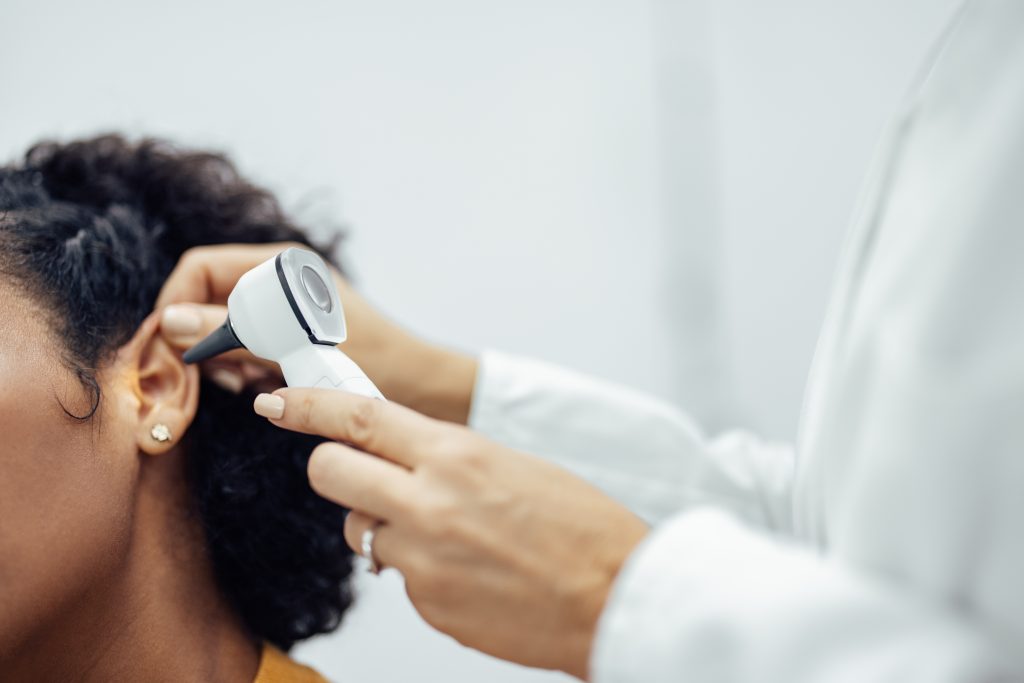Tympanoplasty Surgery
Tympanoplasty is a surgical procedure used to address a condition called ruptured eardrum, which is when there is a hole in the eardrum that impacts one’s hearing ability. In cases where simple treatments like ear drops or antibiotics are not effective in healing the ruptured eardrum, healthcare providers may opt for tympanoplasty as a solution. This involves accessing the eardrum during surgery and repairing the hole by patching it up.

Why Is a Tympanoplasty Done?
When the eardrum has a persistent hole that does not heal naturally, doctors perform a surgical procedure called tympanoplasty. The purpose of this procedure is to enhance hearing ability and prevent water from entering the middle ear.
Kids can get a hole in an eardrum from:
- infections that result in the rupture of the eardrum
- Ear ventilation tubes that come loose or are taken out
- damage caused by inserting a cotton swab into the ear, resulting in a punctured eardrum.
- cholesteatoma, a growth located within or behind the eardrum
Frequently, the eardrum has the ability to heal on its own. Therefore, instead of immediately fixing a hole in a child’s eardrum, doctors typically opt to closely monitor it. In the case of very young children, doctors may wait for several years before performing the repair. This delay allows the ear to fully develop, reducing the likelihood of complications following the surgery. Similarly, if a child is experiencing continued issues with ear infections, the surgery may also be postponed.
Types of Tympanoplasty
Tympanoplasty is a surgical procedure employed in both adults and children for the purpose of treating a punctured eardrum and/or reconstructing or mending the middle ear’s bones.
Specialist surgical otolaryngologists utilize five different types of tympanoplasty procedures.

- Type 1: It is common to utilize a graft (myringoplasty) for the purpose of repairing a perforation in the eardrum.
- Type 2 is employed in the process of fixing the eardrum and ossicles.
- Type 3 procedures involve the extraction of the larger ossicles, namely the malleus and incus, in order to establish a direct connection between the eardrum and the smaller ossicle known as the stapes.
- Type 4 method is employed to fix issues with the stapes.
- Type 5: Involves the removal of a portion of the ear canal’s bone, known as the mastoid bone, with the intention of enhancing sound transmission (referred to as mastoidectomy).
The surgical approach for treating the condition can either be through the ear canal or through a cut made behind the neck, depending on the specific case.
What happens during tympanoplasty?
A straightforward eardrum repair can take place in a doctor’s office using local anesthesia. However, when it comes to most patients, especially children, tympanoplasty is typically carried out in an operating room with general anesthesia. In general, patients are able to be discharged on the same day.
Once the patient has drifted into a state of unconsciousness due to the administration of anesthesia:
- In order to address a hole in the eardrum and potential damage to the ossicles, the surgeon can either enter through the ear canal or make an incision in front of or behind the ear. The specific approach chosen is determined by factors such as the size and location of the hole.
- Once the hole in the eardrum is identified using a microscope or endoscope, the surgeon eliminates the edges of the hole and proceeds to seal it using a graft. This graft can be made from the patient’s own tissue or a synthetic material. The purpose of the graft is to help facilitate the growth of new cells, which eventually leads to the closure of the hole in the eardrum. The graft can either cover only the hole or the entire eardrum.
- Depending on the type of tympanoplasty, the graft is attached to the ear canal and other structures, using a spongy packing that gradually dissolves as the eardrum tissue regenerates and heals. This healing process typically lasts for several weeks to months.

The length of the surgery varies depending on the extent of the repairs needed. For instance, fixing a small hole in the eardrum might only take a few minutes, whereas more complicated procedures like rebuilding the ossicles or extracting the mastoid bone could take several hours.
After the Surgery
If there are no issues, you will be allowed to leave the hospital after staying overnight for observation following your procedure. In some cases, you may even be discharged and sent home on the same day as the surgery.
Whether you return home on the same day or the following day, it is necessary for someone to accompany you and drive you home. This is because it takes a considerable amount of time for the effects of the anesthesia to completely fade away, and it is only deemed safe to operate a vehicle once it has fully worn off.
After you are authorized to leave, you will receive instructions on what to do next. It is important to abide by your surgeon’s guidance and proceed cautiously, even if you feel alright. Overexerting yourself can impede your body’s healing ability and lengthen the time it takes to recover.
It is recommended to refrain from intense physical activity, pushing oneself too hard, and lifting heavy objects (weighing more than 20 pounds) for a minimum period of two weeks.
To decrease swelling, raise the head of your bed when you are sleeping. It may also require some time for your hearing to get better after a tympanoplasty, so be understanding and patient with your progress during the initial stages of healing.
Treatment in Türkiye:
The medical staff of surgical teams, doctors, and consultants at REHABTÜRK can provide the best treatment options and free consultations, striving to stay up-to-date on the latest medical technologies and methods.
